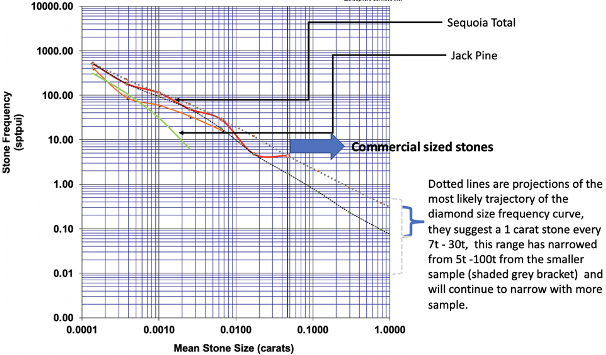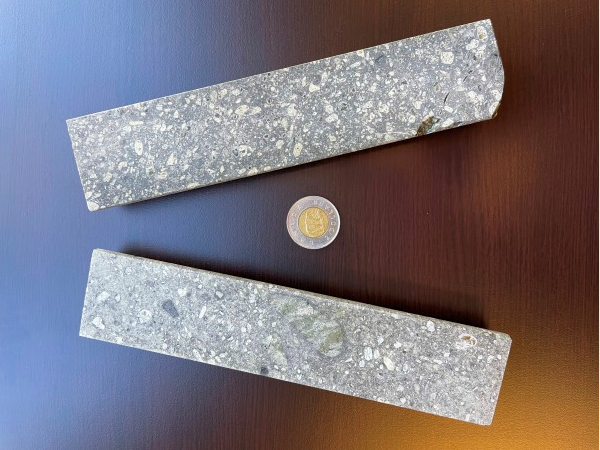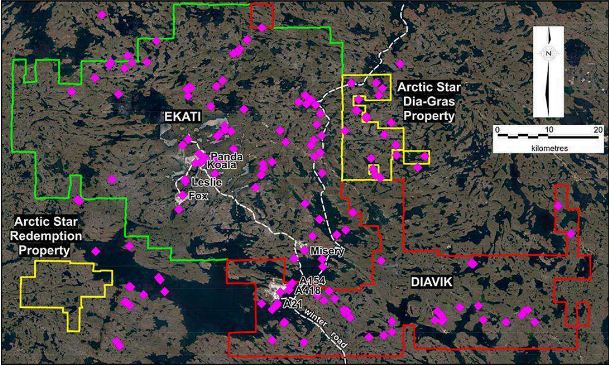Full size / Two halves of split drill core from Arctic Star‘s Sequoia Kimberlite with a Toonie for reference, displaying Hole DG2021-05 on top and Hole DG2021-04 below.
Disseminated on behalf of Arctic Star Exploration Corp. and Zimtu Capital Corp.
Almost exactly 30 years after the announcement by Chuck Fipke‘s Dia Met Minerals Ltd. in November 1991 to have found 89 microdiamonds in a 59 kg drill core sample in the vicinity of Lac de Gras, NWT, Pat Power‘s and Buddy Doyle‘s Arctic Star Exploration Corp. today announced to have recovered commercial-sized diamonds from the other half of the core from Discovery Hole DG2021-04 at the recently found Sequoia Kimberlite Complex located some 30 km east of the Ekati, North-America‘s first diamond mine that began mining operations in 1998.
The Ekati discovery launched “the world‘s largest traditional (on the ground) staking rush“ in the 1990s and it remains to be seen what effect today‘s announcement by Arctic Star may have for the region and its major mining companies fiercely looking to extend the life of its diamond operations.
If the other half of the core of Discovery Hole DG2021-04 would have been sent first for caustic fusion diamond count, maybe last week‘s announcement by Arctic Star would have been perceived differently by the market. On the other hand, this now gives even more credibility to Chuck Fipke, Buddy Doyle and Pat Power with respect to their expertise in conducting scientific research including diamond indicator+inclusion geochemistry analysis, aiming to predict the possibility of large diamonds at Sequoia prior to today‘s news-release announcing the first find of commercial-sized diamonds in drill core:
“Two of the greatest diamond mine discoverers see mounting evidence for large diamonds at Arctic Star‘s newly discovered Sequoia Kimberlite, Diagras Project, NWT“ (September 9, 2021)
“New Diamond Discovery in Canada Now Official: Premier drill results from Arctic Star confirm Sequoia kimberlite to host diamonds“ (July 6, 2021)
The half of the core from Discovery Hole DG2021-04 that was sent first for assays was announced on July 6 to have a “high“ and “very encouraging“ microdiamond count of 76 stones/100 kg (total of 224 stones in 292.6 kg of core). However, it only showed microdiamonds with sizes up to 0.6 mm, thus no commercial-sized stones (>0.8 mm) were found. The other half of the core was recently sent for caustic fusion and included 2 commercial-sized stones: One at 0.85 mm and the other at 1.18 mm. In total, 255 stones were recovered from 212.7 kg of core (120 stones/100 kg) as announced today:
Today‘s news-release from Arctic Star:
Second Round of Caustic Fusion Diamond Results Strengthens Previous Results, Sequoia Kimberlite Complex
Highlights
• Caustic fusion results from the other half of the Sequoia kimberlite 2021 drill core bolsters those reported earlier and continues to hint at the presence of large diamonds.
• Diamond indicator chemistry also points at the likelihood of larger diamonds (>50ct).
• Results suggest a 5t caustic fusion sample would be the appropriate minimum size to predict grade, by obtaining enough >1.18mm stones to understand the size vs. frequency distribution of the global diamond population.
September 15th, 2021 - Vancouver, British Columbia – Arctic Star Exploration Corp. (“Arctic Star” or the “Company”) (TSXV: ADD) (Frankfurt: 82A2) (WKN: A2DFY5) (OTC: ASDZF) is pleased to announce that it has received the second round of caustic fusion diamond results from the Sequoia Kimberlite complex. The results are from the remaining half of the drill core recovered from drill holes DG 2021 04 and DG 2021 05 drilled 202m apart in the central and northern parts of the Sequoia Kimberlite complex.
The results are given in Table 1. The entire core has now been fused, totaling 505 kg. Usually, half the core is kept for reference, but due to the encouraging results from the diamond assays in the first half of the core and the encouraging indicator mineral results reported in the news release dated 7th September, the decision was made to fuse the entire core.
The samples were taken at the same intervals as the first and they confirm that the different rock types have different diamond counts. The indicator minerals also demonstrate that the two main rock types, the volcanoclastic kimberlite and coherent kimberlite are different. While both have indicators equivalent to those found in the population of large diamonds found around the world, and diamond inclusion chromite, only the coherent kimberlite has significant “G10” and eclogitic garnets with diamond inclusion chemistry.

Full size / Table 1. Caustic Fusion Results, Sequoia Kimberlite, Arctic Star JV. The Sequoia caustic fusion results were processed through SRC laboratories of Saskatoon, NQ core was hand split and bagged in approximately 8kg samples to fit geological intervals where possible, the first half of core was sent and processed, then the second half of the core was sent using the same sample intervals. Both samples were sent by chain of custody, SRC is an independent lab and an ISO ……. Samples are placed in a kiln, heated to 5080C with caustic soda for 24 hours. The residue is hot poured through a 0.075mm sieve. The residue is then further chemically treated if required until just the refractory minerals remain including diamonds. The residue is sized by sieving and then the diamonds are selected by a mineralogist. Larger diamonds (>0.5mm) are described and weighed.

Full size / Figure 1 Size Frequency plot: Diamond size distribution. Sequoia original sample in Orange, Sequoia total sample this news release in red, Jack Pine in Green. Figure 1 also depicts possible trajectories for the Sequoia diamond distribution.
Mr. Buddy Doyle commented, “These results demonstrate how “noisy” diamond results can be, with higher diamond counts and larger diamonds showing up when we fused the second half of the core! This is not unusual, it’s all down to collecting enough sample. The current results suggest that a kimberlite sample of approximately 5t, ten times the sample we have to date, would produce a smooth diamond size frequency curve from which a first (global) grade estimate could be made. Such a sample should provide further guidance to the probability of really large stones. Drilling using HQ sized core at 100m spacing within the Sequoia kimberlite complex planned for Spring 2022 will be able to achieve this. Results to date are encouraging, considering the small sample size, and suggest grades that will fall within the range of kimberlites being mined in the Lac de Gras field, (where pipes with grades of 0.3 c/t to 4.2c/t are being mined or are in mine plans), with a possible added bonus of higher propensity of larger stones as suggested by indicator data. The Sequoia complex is large and the extra drilling will also help define tonnage. More work will tell.”
Qualified Person
The Qualified Person for this news release is Buddy Doyle, AUSIMM, a Geologist with over 35 years of experience in diamond exploration, discovery, and evaluation. Mr. Doyle led the team that discovered the kimberlites being mined at Diavik and 100 other kimberlites in the Lac de Gras field. He also received the Hugo Dummitt award for excellence in diamond exploration in 2005.
About Arctic Star
Arctic Star is predominantly a diamond explorer, recently discovering 5 new kimberlites in the prolific Lac De Gras kimberlite field that supports 2 multi-billion dollar kimberlite mining complexes. The company also has a 958Ha Exploration permit containing several diamond bearing kimberlites on its Timantti project, Kuusamo Finland. Arctic Star has optioned its Stein diamond project in Nunavut to GGL diamonds who plan work once Covid restrictions lift. The company continues to look for appropriate diamond opportunities elsewhere.
Neither the TSX Venture Exchange nor its Regulation Services Provider (as that term is defined in the policies of the TSX Venture Exchange) accepts responsibility for the adequacy or accuracy of this release. Cautionary Statement Regarding “Forward-Looking” Information: This news release contains “forward-looking statements” including but not limited to statements with respect to Arctic Star’s plans, the estimation of a mineral resource and the success of exploration activities. In this release it is not certain if the kimberlite discovered will be economic or not as this depends on many factors. Forward-looking statements, while based on management’s best estimates and assumptions, are subject to risks and uncertainties that may cause actual results to be materially different from those expressed or implied by such forward-looking statements. There can be no assurance that such statements will prove to be accurate, as actual results and future events could differ materially from those anticipated in such statements. Factors that could affect our plans include our potential inability to raise funds as intended, and in such event we may require all funds raised, if any, to be used for working capital rather than the intended uses as outlined. Accordingly, readers should not place undue reliance on forwardâ€looking statements. Arctic Star undertakes no obligation or responsibility to update forwardâ€looking statements, except as required by law. (Source)
“The Ekati mine, including the Misery underground and the Jay project, has a current mine life of 2034. To extend the operational life of the Ekati mine to 2042, certain exploration and project evaluation activities are being undertaken.“ (NS Energy in December 2020)
“Further expansion of underground mining operations at the Ekati diamond mine could keep the mine in business until 2042, according to a preliminary economic assessment released by Dominion Diamond Corporation on Wednesday... The Fox Deep project would expand the mine by developing an underground operation below the mined-out Fox open pit. It follows on the Misery Deep project, which the company says will expand the life of the mine from 2033 to 2035. Tom Hoefer, executive director of the NWT & Nunavut Chamber of Mines, says Yellowknifers should be doing a happy dance. “A year ago we thought that Ekati had a life to 2021,“ says Hoefer. “And so with their work on other pipes and now adding Fox in they‘ve created a very exciting future for the N.W.T.‘s mining industry.“ Hoefer points to one of the Northwest Territories‘ other major diamond operations, Diavik Diamond Mine, which is also partially-owned by Dominion. “We know that in 2025 Diavik is going to close,“ Hoefer says. “That‘s going to be a significant hit on our economy because that‘s about a 1,500-person operation.“ Hoefer says the expansion of Ekati‘s underground operation will be a “significant injection“ to the Northwest Territories economy.“ (CBC in September 2017)
“About 200 kilometres south of the Arctic Circle, at the bottom of Lac de Gras, sit some of the world’s most beautiful and sought-after diamonds. This is the Diavik Diamond Mine, in Canada’s Northwest Territories, also home to our award-winning wind farm. Our diamonds from Diavik are stunning white gems, produced to the highest possible standards of safety and integrity. Diavik comprises four diamond-bearing pipes that we mine using a combination of open pit and underground mining. The Diavik Diamond Mine is managed by Rio Tinto and is owned by a joint venture between Diavik Diamond Mines (2012) Inc., a wholly owned subsidiary of Rio Tinto (60% ownership) and Dominion Diamond Diavik Limited Partnership, a wholly owned subsidiary of Dominion Diamond Mines (40% ownership).“ (Rio Tinto)
“All mines have a finite life cycle and Diavik has planned for its closure from the outset. The buildings on site have been designed to be removed without a trace. And when mining ends, the embankments will be reclaimed and lake water will flow back into the open pit.“ (Rio Tinto)
“Accordingly, we look for commercial opportunities to repurpose assets to reduce the social and economic impact of closure.“ (Rio Tinto)
Excerpts from “25 Years of Diamonds“ (Silver Anniversary Special Edition, Mining North, 2016):
Company Details
![]()
Arctic Star Exploration Corp.
1111 West Georgia Street
Vancouver, B.C. V6E 4M3, Canada
Phone: +1 604 689 1799
Email: info@arcticstar.ca
www.arcticstar.ca
Shares Issued & Outstanding: 118,491,751
Canadian Symbol (TSX.V): ADD
Current Price: $0.125 CAD (09/14/2021)
Market Capitalization: $15 Million CAD
German Symbol / WKN (Tradegate): 82A2 / A2PV9M
Current Price: €0.087 EUR (09/14/2021)
Market Capitalization: €10 Million EUR
Contact:
Stephan Bogner (Dipl. Kfm., FH)
Rockstone Research
8260 Stein am Rhein, Switzerland
+41-44-5862323
info@rockstone-research.com
www.rockstone-research.com
Disclaimer: This report contains forward-looking information or forward-looking statements (collectively "forward-looking information") within the meaning of applicable securities laws. Forward-looking information is typically identified by words such as: "believe", "expect", "anticipate", "intend", "estimate", "potentially" and similar expressions, or are those, which, by their nature, refer to future events. Rockstone Research, Zimtu Capital Corp., and Arctic Star Exploration Corp. caution investors that any forward-looking information provided herein is not a guarantee of future results or performance, and that actual results may differ materially from those in forward-looking information as a result of various factors. The reader is referred to the Arctic Star Exploration Corp.’s public filings for a more complete discussion of such risk factors and their potential effects which may be accessed through the Arctic Star Exploration Corp.´s profile on SEDAR at www.sedar.com. Please read the full disclaimer within the full research report as a PDF (here) as fundamental risks and conflicts of interest exist. The author, Stephan Bogner, holds a long position in Arctic Star Exploration Corp. and is being paid by Zimtu Capital Corp., which company also holds a long position in Arctic Star Exploration Corp., whereas the featured company Arctic Star Exploration Corp. pays Zimtu Capital Corp. for the preparation, publication and additional distribution of this report.












